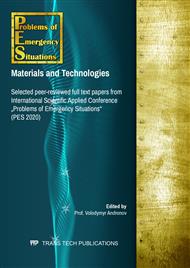[1]
Convention on the prohibition of the development, production, stockpiling and use of chemical weapons and on their destruction. United nations, (1993).
DOI: 10.18356/fa58b405-en
Google Scholar
[2]
A.G. Vetoshkin, Theoretical foundations of environmental protection, Moscow, 2008. [in Russian].
Google Scholar
[3]
Donald W. Breck., Zeolite molecular sieves, Structure, chemistry, and use, New York, Wiley, (1974).
Google Scholar
[4]
L. Patrylak, R. Likhnyovskyi, V. Vypyraylenkoet al, Adsorption Properties of Zeolite-containing Microspheres and FCC Catalysts Based on Ukrainian Kaolin, Adsorption Science & Technology. 7 (2001) 525-540.
DOI: 10.1260/0263617011494376
Google Scholar
[5]
M.W. Ackley, S.U. Rege, H. Saxena. Application of natural zeolites in the purification and separation of gases, Microporous and Mesoporous Materials. 1 (2003) 25-42.
DOI: 10.1016/s1387-1811(03)00353-6
Google Scholar
[6]
Yi Yang, Wenqi Xu, Feng Zhang et al. Preparation of highly stable porous SiC membrane supports with enhanced air purification performance by recycling NaA zeolite residue, Journal of Membrane Science. 541 (2017) 500-509.
DOI: 10.1016/j.memsci.2017.07.040
Google Scholar
[7]
K. Sotiriadis, S. Guzii, P. Mácová et al. Thermal behavior of an intumescent alkaline aluminosilicate composite material for fire protection of structural elements, Journal of Materials in Civil Engineering, 6 (2019).
DOI: 10.1061/(asce)mt.1943-5533.0002702
Google Scholar
[8]
J. Wilson. Active carbons from coals, Fuel, 60 (1981) 823–831.
DOI: 10.1016/0016-2361(81)90145-9
Google Scholar
[9]
NPFC ‒ MIL-DTL-32101 Carbon, Activated, Impregnated, Copper-Silver-Zinc-Molybdenum-Triethylenediamine (ASZM-TEDA), NPFC, 2017, Information on https://standards.globalspec.com/std/10270117/mil-dtl-32101.
Google Scholar
[10]
Israel Standard SI 4570 part 3. Air ventilation and filtration systems for air-raid shelters: Filters, Tel Aviv, Institute of Standards in Israel, 2009. Information on https://www.sii.org.il/en/מוצרים/דף-תקן/?id=526bf291-6673-4814-89a4-cdd327118354_HE.
Google Scholar
[11]
V.M. Mukhin, V.V. Chebykin, E.A. Galkin et al. Active carbons. Elastic sorbents. Catalysts, desiccants and chemical absorbers based on them (Nomenclature catalog), Moscow, 2003. [in Russian].
DOI: 10.1023/b:rjac.0000044143.05591.6f
Google Scholar
[12]
A.A. Nosenko, S.I. Polovneva. Methods and devices for measuring surface area dispersed materials [in Russian], Proceedings of Universities, Applied Chemistry and Biotechnology. 7 (2017) 113-121.
DOI: 10.21285/2227-2925-2017-7-2-113-121
Google Scholar
[13]
S Brunauer, P.H. Emmett, E. Teller. Adsorption of gases in multimolecular layers, J. Am. Chem. Soc. 60 (1938) 309–319.
DOI: 10.1021/ja01269a023
Google Scholar
[14]
F. Rouquerol, J.Rouquerol, K. Sing. Adsorbtion by powders and porous solids. Рrinciples, methodology and application, Academic Press, (1999).
DOI: 10.1016/b978-012598920-6/50004-x
Google Scholar
[15]
ISO 9277:2010 Determination of the specific surface area of solids by gas adsorption — BET method. Information on https://www.iso.org/obp/ui/#iso:std:iso:9277:ed-2:v1:en.
DOI: 10.31030/2066286
Google Scholar
[16]
E. Patrick. Handbook of Sample Preparation for Scanning Electron Microscopy and X-Ray Microanalysis, Cambridge, Springer, (2009).
Google Scholar
[17]
E. P. Barrett, L.G. Joyner, P.P. Halenda. The determination of pore volume and area distributions in porous substances. I. Computations from nitrogen isotherms, J. Am. Chem. Soc. 73 (1951) 373 – 380.
DOI: 10.1021/ja01145a126
Google Scholar
[18]
M. Thommes, K. Kaneko, A.V. Neimark et al. Physisorption of gases, with special reference to the evaluation of surface area and pore size distribution (IUPAC technical report), Pure Appl Chem. 87 (2015) 1051-1069.
DOI: 10.1515/pac-2014-1117
Google Scholar


